
Control line
Encyclopedia

Model aircraft
Model aircraft are flying or non-flying models of existing or imaginary aircraft using a variety of materials including plastic, diecast metal, polystyrene, balsa wood, foam and fibreglass...
. The aircraft
Fixed-wing aircraft
A fixed-wing aircraft is an aircraft capable of flight using wings that generate lift due to the vehicle's forward airspeed. Fixed-wing aircraft are distinct from rotary-wing aircraft in which wings rotate about a fixed mast and ornithopters in which lift is generated by flapping wings.A powered...
is connected to the operator by a pair of lines, attached to a handle, that work the elevator
Elevator (aircraft)
Elevators are flight control surfaces, usually at the rear of an aircraft, which control the aircraft's orientation by changing the pitch of the aircraft, and so also the angle of attack of the wing. In simplified terms, they make the aircraft nose-up or nose-down...
of the model. This allows the model to be controlled in the pitch axis. It is constrained to fly on the surface of a hemisphere by the control lines.
There is also a control system that uses only a single solid wire that is twisted around its own axis, that spins a spiral inside the airplane to move the elevator. While it can be used with some success on any type of model, it is best for speed models where the reduced aerodynamic drag of the single line is a significant advantage. The control provided is not as precise as the two-line control system.
The control lines are usually either stranded or solid wires of anywhere from 0.008 in (0.2032 mm) to 0.021 in (0.5334 mm). Sewing thread or fishing line may be used instead of wires to control very small models, but its air resistance is greater. A third line is sometimes used to control the engine throttle, and more lines may be added to control other functions. Electrical signals sent over the wires are sometimes used in scale models to control functions such as retracting undercarriage and flaps.
Almost all control-line models are powered with conventional model aircraft engines of various types. But it is possible to fly control-line models that do not use on-board propulsion, in a mode called "whip-powered", where the pilot "leading" the model with his arm and wind supply the necessary energy to keep the airplane aloft, in a fashion similar to kite-flying.
History
Models on lines and flying in circles predate manned flight. Early versions merely constrained the model to fly in a circle but offered no control. This is known as Round-the-pole flyingRound-the-pole flying
Round-the-pole flying is a form of flying model aircraft, in which the model is attached via a line from its wingtip or fuselage to a central support structure. Control signals can be passed to the model via wires alongside or integral with the attachment line. The operator can control the...
. The origins of control-line flight are obscure but the first person to use a recognizably modern system is generally considered to be Oba St. Clair, in June 1936, near Gresham, Oregon. But the name most associated with the promotion of control line, and the inventor of the formerly patented system known as "U-Control" (which was a trademark) was Nevilles E. " Jim" Walker. His "American Junior" company was by far the biggest producer of models, and held numerous patents on the two-line system until overturned based on "prior art" from St. Clair in a 1955 court trial. One of the most coveted prizes in control-line aerobatics competition, awarded to the winner of a flyoff between the US Junior, Senior, and Open age class Champions, was originally provided by and is named for Walker. This is one of the oldest perpetual trophies in modeling that is still awarded.
The airframe
Control-line models are built of the same basic materials and construction methods as R/CRadio control
Radio control is the use of radio signals to remotely control a device. The term is used frequently to refer to the control of model vehicles from a hand-held radio transmitter...
and free flight
Free flight (model aircraft)
The segment of model aviation known as free flight is the original form of the aeromodeling hobby, extending back centuries.- Description :...
models. Control-line model construction varies with the category of model. Aerobatics and combat models are relatively lightly built compare to R/C models as they need high maneuverability in the limited space offered by the control line "hemisphere". They are typically built with traditional materials like balsa wood, plywood, paper, plastic, spruce, and polystyrene foam, but modern composite and graphite/epoxy are occasionally used in high-load applications. Combat models must also be relatively easy and quick to build, as mid-air collisions and crashes are very common. Aerobatic model construction is typically quite complex and may require many hundreds of hours. Speed models must be very sturdy to withstand the forces of line tension and to permit a very rigid engine mount for maximum engine performance. Speed models are generally built around an aluminum or magnesium "pan" that forms about half the fuselage. Little or no maneuverability or even lift is required, as once at speed the model's altitude is maintained by centrifugal force
Centrifugal force
Centrifugal force can generally be any force directed outward relative to some origin. More particularly, in classical mechanics, the centrifugal force is an outward force which arises when describing the motion of objects in a rotating reference frame...
. Racing models need to be both relatively light for good acceleration from the start, or pit stop, but must also be fairly strong to withstand the pit man catching the model at high speed.
To control the airplane, the lines must remain in tension. Centrifugal force
Centrifugal force
Centrifugal force can generally be any force directed outward relative to some origin. More particularly, in classical mechanics, the centrifugal force is an outward force which arises when describing the motion of objects in a rotating reference frame...
is generally sufficient to maintain line tension if the airplane is properly "trimmed" (adjusted), but sometimes additional features such as rudder offset and engine offset are added to provide extra tension. Weight in the outboard wing tip is usually used to balance the weight of the lines. Top aerobatics models typically have a large number of adjustable features like tip weight boxes, adjustable rudder offset, adjustable line sweep, and adjustable elevator and flap controls. Some aerobatics models use a variable rudder system (commonly called the Rabe rudder after its inventor, Al Rabe) to vary the rudder offset during flight. The adjustment of the various adjustable features on a modern stunt model can become quite complex.
Many models also feature a longer inboard wing; aerobatics models use this to balance the lift from side-to-side, compensating for the difference in velocity from inboard to outboard wing, while some speed models use a very exaggerated longer inboard wing to provide streamlining of the flying lines. On small speed models the drag of the flying lines can be three times the drag of the rest of the model.
In general there are two types of fuselage construction that are used in control line - "profile" (flat) and "built up". These are built with differing types of wings depending on the specific use of the aircraft. Profile models, where the fuselage is cut out from a single relatively thin sheet of wood with the "profile" of the airplane, are simple to build and repair, and are very common on trainer models. Sometimes the vibration of the engine causes poor engine runs on profile models. Built-up fuselages are much more difficult to build but generally look better and offer superior engine runs.
Controls
The aircraft is typically controlled by a set of 20-70-foot lines usually of multi strand stainless steel or single strands of music wire. For competition the lines are tested before flight with a "pull test" that varies with the model weight and category to verify that the lines and control system (primarily the bellcrank and its attachment to the rest of the model) will withstand the tension in flight. For sport flying, non-metallic lines of kevlar, dacron, or other low-stretch materials are sometimes used. This type of control was originally trademarked as "U-Control" and is by far the most common control method.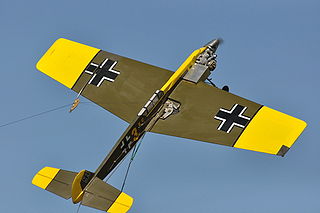
The controls can be expanded by adding a third line that controls the throttle. The throttle is usually a conventional carburetor as used on radio control models Schemes that couple limited rudder and/or aileron, and variable leadout position are often found on carrier planes as well as elevator and flaps/
Monoline control works by twisting the single line. The pilot holds a handle with a twisted flat piece of metal on bearings in one hand, and a "bobbin" in the other. Moving bobbin towards or away from the handle twists the line. Inside the airplane, the rotating line rotates a spiral scroll with a follower. The follower moves towards and away from the pivot of the scroll, and has a pushrod attached. The as the scroll rotates, the pushrod moves fore and aft. The rest of the system is like the two-line system. The control of a monoline system is much less precise than a two-line system because the line itself tends to twist up before it moves the scroll, leading to a somewhat vague control response with considerable lag. It does however have the advantage of not requiring as much line tension to move the controls, and the single line has less drag than the two slightly smaller lines used in conventional two-line control.
Other control methods were devised early on to obviate the need to pay royalties on the "U-Control" patent, including systems with the lines connected directly to the elevator with pulleys to change the direction, methods that connected the lines directly to the pushrod through screw eyes, but most worked very poorly compared to conventional 2-line control.
Power
Control-Line airplanes usually have a power plant of 0.049 cubic inch (8.036E-07 m³) to 0.6 cubic inch (9.84E-06 m³), although engines can be as large as .90, or may have electric power. Two-stroke glow engines are most common, but almost any form of model engine has been used, including both pulse jets and turbojets. Control-line models tend to have very high power-to-weight ratios compared to R/C models or full-scale aircraft. The size of the engines and the models are significantly limited by the maximum line length of 70 feet (21.3 m) used for competition, although very long lines (as much as 150 feet) have been used on rare occasions.The competition categories that need high power output and speed can turn at very high rotational speeds for a reciprocating engine. A 0.15 cu in (2.5 cm³) engine used in the FAI Speed event may produce as much as 3 hp at rotational speeds in the range of 45000 rpm - faster than some full-scale turbojets. The specific output is around 1200 hp/liter which is far in excess of racing motorcycle engines or Formula 1 auto racing engines. Many breakthroughs in two-stroke engine design (both model and motorcycle) can be traced back to C/L speed models, as the small size makes it easy to experiment with new designs at low cost.
Control line models tend to run a varying mix of fuel however 10% nitromethane, 20% Castor Oil and 70% methanol is common. Castor oil is sometimes replaced by synthetics however as control line aircraft typically run at high throttle settings for the entire flight, castor oil generally provides better lubrication and cooling and is considered generally safer for the engine. It is however somewhat viscous and the resulting oil drag can rob some power compared to synthetic oil, and can also lead to "varnishing" of the cylinder. Some older-technology engines commonly used for control line can be very quickly damaged with typical R/C fuels because of low oil content.
Pulse jet models use gasoline, a variety of flammable liquids like acetone, methyl-ethyl-ketone, and other similar fluids. Pulse-jet models are started by applying a continuous spark device (e.g. a "buzzer coil" as used on a Fordson tractor) to a spark plug in the side of the combustion chamber, and then using a bicycle pump or pressurized air to blow air across the fuel injector and into the engine. When a flammable mixture is present in the engine, it will detonate, sending a shock wave down the tail pipe and creating suction at the intake end of the engine, sucking in more fuel/air, and creates another explosion. Once started, the engine becomes hot very quickly and no longer requires the spark. The spark box and air source are disconnected and then model launched as quickly as possile to prevent the tremendous heat generated by the engine from causing the airplane to catch fire. The engine is extremely loud in operation and cannot be muffled, and can be heard for miles under the right conditions.
The propellers used for control-line models are commonly made of wood (usually maple), fiberglass-reinforced plastic, or graphite/kevlar/fiberlass and epoxy. The propeller pitch and diameter are chosen based on the engine size, type of performance desired, and cost. A typical 61-sized tuned pipe Stunt engine uses a 3-bladed propellor around 12-13" in diameter and around 4" of pitch, and is usually made of graphite/epoxy. A 20-sized sport model might use an inexpensive 9" diameter, 4" pitch propellor made of fiberglass-reinforced plastic. The graphite stunt propellers are usually made in small production runs or even by hand, and can cost as much as $50. The small GRP sport prop is made by injection molding and may cost as little as $2.
The fuel for the engine is usually held in a metal or plastic fuel tank, shaped so that fuel is drawn from the outside edge of the tank, as the fuel tends to be thrown to the side by centrifugal force as the airplane travels in a circle. A "clunk tank" as used in R/C is satisfactory, but dedicated tanks with wedge-shaped cross-sections are frequently used and tend to have better characteristics as the fuel runs out. A tank with a vent on the inner edge, or multiple vents, is usually called a 'suction' tank. The pressure of fuel delivery with a suction tank changes as the fuel runs out, causing the engine mixture ratio to become leaner as the flight proceeeds. Tanks vented to only permit air to enter at the outside edge ("uniflow" tanks) provide constant fuel pressure over the duration of the flight and a constant mixture ratio.
Combat and some speed models use rubber tubing ("bladder" tank), baby pacifiers, or fountain pen ink bladders, inflated with fuel in a veterinary syringe, to hold the fuel under fairly high pressure. The fuel line is pinched off to prevent fuel loss until the engine is started. The high pressure of fuel delivery permits the use of a larger intake on the engine, allowing more air flow than would otherwise be possible, and thus more power. The fuel delivery is very steady with this method until the very last bit of fuel runs out, but is logistically difficult because any leak results in streams of fuel spraying out.
The carburetion on most control-line engines is a simple fixed-size orifice (venturi) with only a mixture ratio adjustment. The engine can be run over a very wide range of mixtures and adjusting the needle valve can be used to adjust the engine speed over a small range. Once released, the engine runs at a more-or-less constant speed until the fuel runs out, or, if equipped, the fuel-shutoff is activated. Altering the size of the venturi used can be used to adjust the gross power. Two-stroke glow motors can be made to run in a 4-stroke mode where the engine mis-fires on every other stroke, and changes mode of firing based on load of the propeller. A tremendous degree of control over how the engine runs in flight is possible by altering the fuel contents, propeller size, pitch, and pitch distribution, venturi size, compression ratio of the engine, and the length of the tuned exhaust, if used.
Landing Gear
The landing gear/undercarriage on control line aircraft can vary from rudimentary music wire and wheels to competition models with spring-loaded shock absorption and wheel pants. Retractable landing gear is common on scale models and is occasionally used in stunt. Most speed and combat models omit the landing gear in the interest of drag and weight reduction, and are hand-launched.Navy carrier models have a reinforced hook to help them catch an arresting cable on a simulated carrier deck.
Competitions
Competitions for control line aircraft are held in various classes. These include speed, precision aerobaticsAerobatics
Aerobatics is the practice of flying maneuvers involving aircraft attitudes that are not used in normal flight. Aerobatics are performed in airplanes and gliders for training, recreation, entertainment and sport...
(AKA stunt), team racing, combat, naval carrier, and scale.
Speed
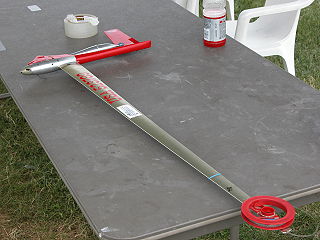
Engine
An engine or motor is a machine designed to convert energy into useful mechanical motion. Heat engines, including internal combustion engines and external combustion engines burn a fuel to create heat which is then used to create motion...
capacity classes and a Jet class (using pulse jet engine
Pulse jet engine
A pulse jet engine is a type of jet engine in which combustion occurs in pulses. Pulsejet engines can be made with few or no moving parts, and are capable of running statically....
s) As the name suggests, the idea is to have the model go as fast as possible. The model is timed over a number of laps, and the pilot must hold the handle controlling his model in a yoke on top of a pole in the middle of the circle. This is in order to stop the pilot from assisting the model to go faster by increasing the line tension and leading the model (known as whipping). Monoline control systems are common in the US, but international classes require the use of two-line control. Speeds of the fastest models - Class D 0.6 cubic inch (9.84E-06 m³) and Jet - have in the past exceeded 220 mi/h. Current US rules limit the speeds to <200 mi/h by requiring the use of larger lines if 200 mi/h is exceeded. Speed models are usually launched from a "dolly" - a cart that permits a lengthy ground roll for takeoff, but drops away in the air to reduce drag. The airplane lands on a skid or belly pan.
Precision aerobatics
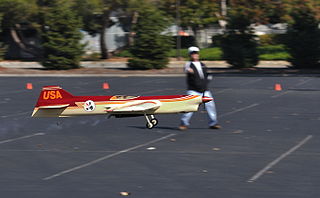
Aerobatic maneuver
Aerobatic maneuvers are flight paths putting aircraft in unusual attitudes, in air shows, dog fights or competition aerobatics. Aerobatics can be performed by a single aircraft or in formation with several others...
s which are judged by a panel of judges for accuracy and precision. The event was originally dubbed "stunt" and current participants refer to it that way informally. Factors such as height of the maneuver bottoms, shapes, corner radius, and other factors are considered. The judges at large competitions are typically trained for several days on how to assess the maneuvers and apply a score. Judging well is generally considered at least as difficult as flying in competition.
Stunt models tend to be among the larger Control Line models, wings usually spanning from around 45–60 in (1.1–1.5 m). Top competition models have been traditionally powered by a two-stroke engine in the 0.35 cubic inch (5.74E-06 m³) to 0.6 cubic inch (9.84E-06 m³) range, with four-stroke model engines and electric power also becoming popular as power sources. The airplanes, while possessing high thrust-to-weight ratios by full-scale standards (usually at least 1:1), are intended to fly quite slowly to enhance pilot control, typically around 55–60 mph (88.5–96.6 km/h), with a single lap of the circle taking around 5.5 seconds. Compare this to a typical speed model that may go 200+ mph (325 km/h).
Engines are commonly set to increase their power output when under load. This permits low speeds but very good speed stability, so the climb performance is excellent. The original scheme used was to take advantage of the tendency of a nominally two-stroke glow engine to change from running in a four-stroke when set with extremely rich mixtures, to running in a two-stroke when the load increases. This is called a "4-2 break". More recently, tuned exhausts have been used to provide regulation of the speed in flight. Combined with propellors of relatively low pitch, this has permitted much more control over the engine's speed and power response to maneuvering. Electric system contain feedback control system that govern the RPM of the motor to a constant value regardless of load
Most competitive aircraft are fitted with flaps on the wings, which work in conjunction with the elevator to increase the pitch maneuverability. When up-elevator is applied, the flaps on the wings go down, and vice versa. This results in the wing, which is otherwise of a symmetrical section, to be cambered in the direction needed to enhance maneuvering. Aircraft without flaps can be flown successfully and are typically simpler, but flapped models typically fly more smoothly and can be heavier. Some of the simpler stunt models make excellent control-line trainers, as the predictable control response, low speed, and strong line tension make them easy to fly successfully. Of course piloting at a the highest levels can be remarkably difficult and time-consuming.
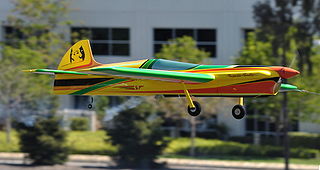
Stunt is flown in many countries, with World Championships being held on alternate years. These are open for any flier who makes his or her respective national team. Competition at the highest levels (National or World Championships) can take many years or decades of practice to master the intricacies of designing, building, finishing, adjusting, and controlling the power of the airplanes, in addition to the high piloting skills. Many top competitive pilots have coaches and spend many hours practicing, much like training for Olympic events.
Many competitions including the U.S. Nationals separate pilots into 4 different skill levels (beginner, intermediate, advanced and expert) allowing pilots to compete against other pilots of similar skill levels.
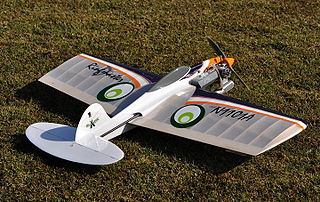
Racing
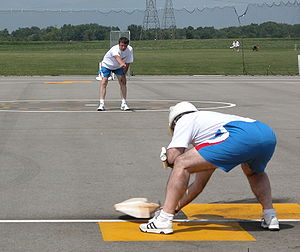
Combat
Combat is an event where two pilots "dogfight" for cuts on their opponent's streamer. Models are fast and highly maneuverable flying-wings, which chase each other around the sky at speeds in excess of 100 mi/h. Despite deliberate mid-airs being banned, the carnage rate is high, and pilots commonly bring 10 or more models to a comp. Combat is a highly tactical event, requiring great teamwork between a pilot and his two mechanics. Control line has the advantage over radio control here, in that the battle is real and direct, perhaps the next-best-thing to a real aerial dogfight!F2D combat - the international class for combat - is most popular in Russia and Europe, where some countries have professional or semi-professional teams. Russia and the former Soviet countries are currently the main producers of world-class equipment for this sport, including engines. Their combination of the latest engineering and design, with exotic metallurgy and experience, results in combat engines which reliably turn 32,000 rpm, and can be restarted easily in the event of a crash. Requiring lightning-fast reflexes, combat has frequently been used as a training-ground and/or hobby for many commercial and military pilots.
Navy carrier
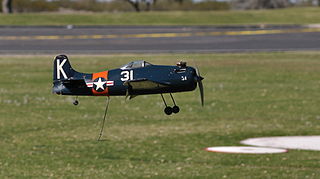
Naval aviation
Naval aviation is the application of manned military air power by navies, including ships that embark fixed-wing aircraft or helicopters. In contrast, maritime aviation is the operation of aircraft in a maritime role under the command of non-naval forces such as the former RAF Coastal Command or a...
are flown. The event replicates the requirements of full-scale carrier aircraft
Carrier-based aircraft
Carrier-based aircraft are military aircraft designed specifically for operations from aircraft carriers. The term is generally applied only to fixed-wing aircraft, as naval helicopters are able to operate from a wider variety of aviation-capable ships. Carrier-based aircraft must be relatively...
, which need high speed for combat performance, low speeds and toughness for safe carrier landings. Takeoff and landing are from a simulated aircraft carrier
Aircraft carrier
An aircraft carrier is a warship designed with a primary mission of deploying and recovering aircraft, acting as a seagoing airbase. Aircraft carriers thus allow a naval force to project air power worldwide without having to depend on local bases for staging aircraft operations...
deck, with arrestor wire
Arresting gear
Arresting gear, or arrestor gear, is the name used for mechanical systems designed to rapidly decelerate an aircraft as it lands. Arresting gear on aircraft carriers is an essential component of naval aviation, and it is most commonly used on CATOBAR and STOBAR aircraft carriers. Similar systems...
s. The aim of the flight is to complete a number of fast laps, flown as quickly as possible, followed by a number of slow laps, flown as slowly as possible. This is followed by the carrier deck landing, attempting to snag the arrestor wire. The score depends on the difference of the high and low speed, and the arrested landing. Carrier models usually have a third control line, worked by a finger trigger in the handle. This line allows the throttle setting of the engine to be controlled and the arrestor hook to be dropped. Often, a carrier model will have flaps. Unlike a stunt model, however these flaps are worked separately from the elevator. A large amount of flap is usually applied during the slow laps, and a large amount of line sweep is added to yaw the model out of the circle to maintain line tension at the very low ground speeds. Low speeds are frequently no faster than a fast walk, and when aimed into a light breeze forward motion may stop completely with the model hanging at a very high angle of attack from the propeller.
Scale
Scale is an event where an accurate scale model of a real aircraft is flown. Scoring is based on static judging of how closely the aircraft resembles the full-size prototype and on the flight performance. Extra points are often awarded for "working" features of the model, such as a retractable landing gear, droppable bombs, and other prototypical functions or operations. The number of features used to be limited by the number of lines that could be practically used to mechanically control them. Some complex scale models use a fly-by-wire approach to allow a multitude of extra working features. A radio-control transmitter can be adapted to send its control signals along insulated control lines, instead of broadcasting them using radio frequencies. Multiplexing of the control signals permits many functions to be controlled without the use of additional lines. Standard servoServomechanism
thumb|right|200px|Industrial servomotorThe grey/green cylinder is the [[Brush |brush-type]] [[DC motor]]. The black section at the bottom contains the [[Epicyclic gearing|planetary]] [[Reduction drive|reduction gear]], and the black object on top of the motor is the optical [[rotary encoder]] for...
s can then be used in the model.
Safety
Control-line flying is generally quite safe when all prescribed safety measures are followed. The airplane is constrained to fly in a circle, which is generally marked. A pilots' circle is also provided, so as long as the pilot stays in the pilot's circle and everyone else is outside the outer circle, it can hit no one. In most competition categories, a "safety thong" connecting the control handle to the pilot's wrist is also required, so if the pilot inadvertently releases the handle, the airplane cannot fly outside the circle (and, frequently crashes, safely for others if not the airplane, when control is lost). The lines, handle, and control system are subjected to a "pull test" before flight to ensure that they are in good shape with some significant margin. For example, the pull test is around 40 lb (18.1 kg) for a 4 lb (1.8 kg) Stunt model (a 10G load), and the in-flight pull is around 10 lb (4.5 kg). This provides a 2x margin of safety even if one line should fail. One failed line immediately moves the elevator to the extreme of its movement, which almost always results in a crash but safely in the circle. Other categories of model are tested in a similar way, with the loads set to correspond to the expected speeds with around a factor of 4 margin.Combat models, albeit very rarely have their lines cut or otherwise broken by the other airplane, and can fly outside the circle. Most combat competition today requires that the airplane be equipped with a device that shuts off fuel to the engine if the lines are cut. This can work by either using the centrifugal force to keep the shutoff from pinching the line, or by using the line tension to hold the pinch-off device open. This way, the engine is not running and tends to decelerate very quickly instead of accelerating quickly (since the drag of the lines is removed) as it would otherwise. This technique has proved to be very effective in practice. Many combat events also require the engine to be attached to the bellcrank with a cable, so that a mid-air collision will not result in the engine flying off and into the spectators. Competitors in some forms of combat competition are also required to wear helmets.
Another potential safety issue is overhead power lines. Contact with power lines, or approaching high-tension power lines, is potentially fatal and has caused several deaths.
Sometimes models with landing gear are flown by using a "stooge" that holds the airplane until released by the pilot from the center, usually with a spring-loaded pin pulled with a string. This allows a pilot to practice with no helper, and is common with stunt fliers trying to practice extensively. This has the potential to be dangerous if the pilot fails to properly reset the stooge, the wire connecting the stooge to the airplane (usually attached to the tail wheel) breaks, the stooge moves under the thrust/vibration of the engines, or the pilot's feet get tangled in the stooge release line. If anything does go wrong, and the pilot is injured, there is no assistance.
The other safety issues are common with other powered model categories. Hand-starting very powerful engines as used in stunt, with very sharp propellers, can be quite hazardous if proper precautions are not followed. The use of an electric starter can help in some cases, but other hand-starting methods are reasonably safe. One such method is the "back-bump" method, where the engine is choked and flipped through with no battery attached to create favorable starting conditions. Once prepared, all that is necessary is to rock the engine backwards so that it coasts up to compression, and if done correctly, starts forwards. This provides time to move the hand out of the way and the fingers are not in contact with the propeller or spinner when the engine starts. Care must be taken even choking the engine as modern engines with their excellent piston/cylinder fit can "bump" or even start without the battery attached. Once the engine is running, extreme care must be taken when preparing for flight and adjusting the engine to not allow any body part to get into the prop disc. A starting accident frequently results in a small cut to the finger, but once the engine is at full speed any injury that is encountered is likely to be quite severe.
Pulse jet engines get extremely hot once started, and use very volatile fuels like gasoline or methyl-ethyl-ketone (as contrasted to relatively benign, although flammable, glow engine fuel). Contact of any type with the tailpipe of the engine is certain to result in severe burns, as the engine reaches red-hot temperatures in seconds. The airplane itself needs some sort of insulation to prevent catching fire on the ground before forward motion provides cooling air, and fully enclosed engines can set the airplane on fire after landing. The airplane should be launched as soon as possible after the engine starts to prevent heat-buildup. The spark unit used for starting can also deliver a substantial electrical shock. Extreme care should be taken and a fire extinguisher should be at hand at all times when operating the engine. The engine is exceptionally loud when operating and should be operated with hearing protection to prevent damage.
See also
- Model aircraftModel aircraftModel aircraft are flying or non-flying models of existing or imaginary aircraft using a variety of materials including plastic, diecast metal, polystyrene, balsa wood, foam and fibreglass...
- Round-the-pole flyingRound-the-pole flyingRound-the-pole flying is a form of flying model aircraft, in which the model is attached via a line from its wingtip or fuselage to a central support structure. Control signals can be passed to the model via wires alongside or integral with the attachment line. The operator can control the...
- Tether carTether carTether Cars are model racing cars powered by miniature internal combustion engines and tethered to a central post. Unlike radio control cars, the driver has no remote control over the model's speed or steering.-Basics:...
s - Cox ModelsCox ModelsCox Models, a former division of Estes Industries of Penrose, Colorado, was a multimillion-dollar hobby company, is one of the hobby industry's oldest companies and is noted for its production of miniature model internal-combustion engines....
- Cox model engine
Organizations
- AMA - Academy of Model Aeronautics USA
- MAAC - Model Aeronautics Association of Canada
- CLAPA - Control Line Aerobatic Pilots Association UK
- MAAA - Model Aeronautical Association of Australia
- PAMPA - Precision Aerobatics Model Pilots Association USA
- MACA - Miniature Aircraft Combat Association USA
- NCLRA National Control Line Racing Association USA
- CFA - Combat Flyers Association UK
- CLP - F2 - Control Line Portugal PT
Non Commercial
- Australian Control Line Nostalgia
- Australian Control Line Forum
- Barton Model Flying Club Control Line Forum
- Control Line Aircraft Society NSW
- Control Line Combat
- Cox Model Engine Museum
- Kuringai Model Flying Club
- Stuka Stunt Works
- Stuka Stunt Control Line Forums
- StuntHangar Control Line Forums
- Taiwan Control Line Forum
- Scale Control Line Models UK
- Flying Lines, Daily News of Pacific Northwest Control Line Model Aviation
Commercial
- ViKo Models MFT - All for F2D CL Combat
- Aeromaniacs Control Line Page
- Black Hawk Models Control Line Kits
- Brodak Control Line Kits and Supplies
- The Hobby Cave Control Line Kits and Supplies
- RSM Distribution Control Line Kits and Supplies
- Sams Stuff & Hobbies Control Line Kits and Supplies
- SIG Manufacturing Control Line Kits and Supplies

